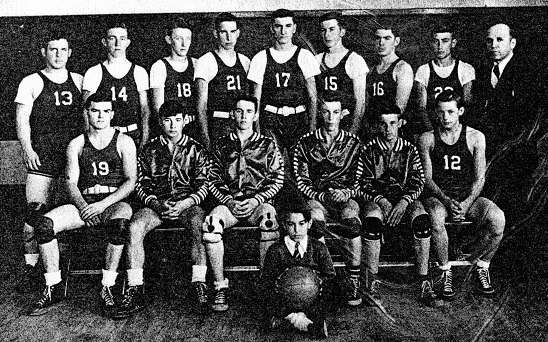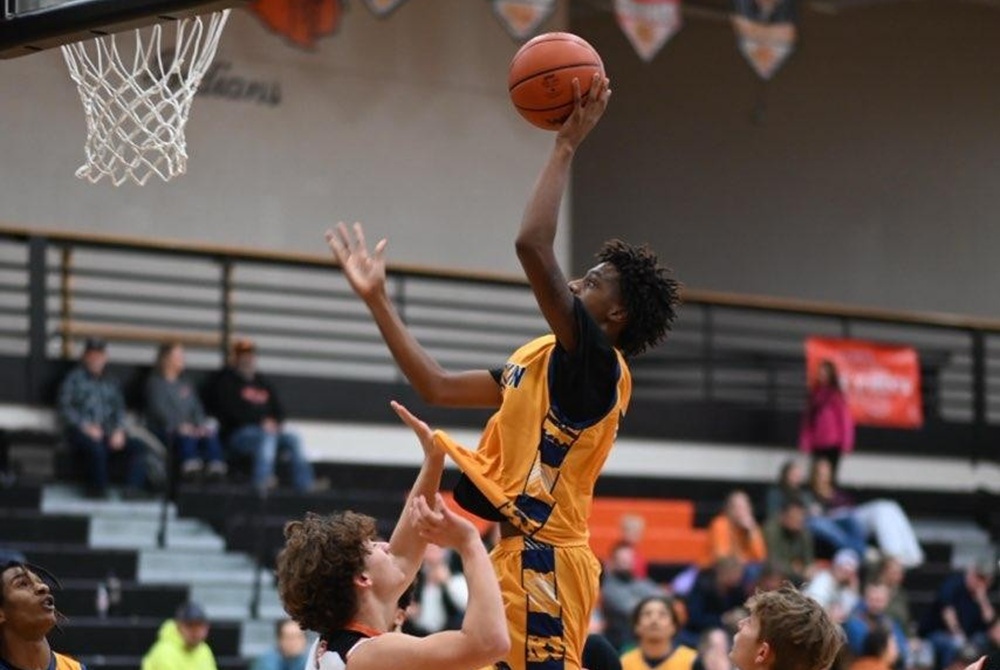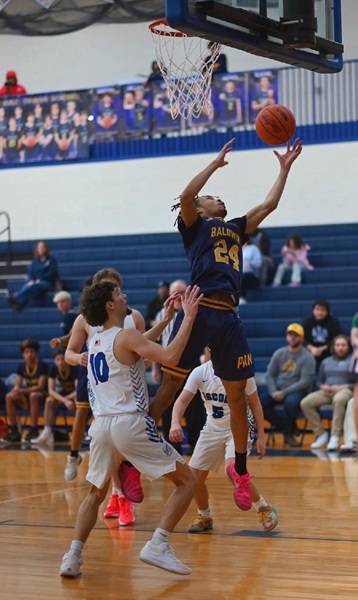
Before the Bridge: Class E & the UP
By
Ron Pesch
MHSAA historian
July 31, 2017
This is the final part in a series on MHSAA tournament classification, past and present, that has been published over the last two weeks and originally ran in this spring's edition of MHSAA benchmarks.
The stories are worthy of the silver screen.
Long lost legends of lore, forgotten by most in the Lower Peninsula of the state of Michigan.
Absurd anecdotes of basketball played behind glass, and out-of-bounds lines painted on walls.
Tales of overlooked places like Trenary and Champion and Doelle and Watersmeet.
This is the story of MHSAA Class E basketball.
From 1932 to 1947, Michigan's Upper Peninsula did not compete in the state-sponsored basketball tournament. Instead, the U.P. held a separate basketball tournament, crowning champions in Classes B, C and D. In 1941, the state added a fifth classification – Class E, comprised of schools with a student body numbering 75 or fewer. A fourth bracket was added to the U.P. tourney.
Following the 1948 season, the Upper Peninsula returned to the state tournament. Winners of the traditional U.P. tourney were pronounced regional champions, and advanced to the state quarterfinals in Classes B, C and D. However, since there were no Class E schools with basketball teams in the Lower Peninsula, the winner of the U.P. tournament crown was proclaimed Class E state champion. This arrangement continued through the spring of the 1960 season.
Since they were the state's smallest high schools, the gymnasiums came in all shapes and sizes. Some sported a center circle that intersected with the top of the key. Basketball courts that doubled as a stage required netting to keep the kids and the ball on the court and away from the audience seated below.
Fred Boddy, a former coach at Champion, recalled his first visit to Doelle. Located in copper country near Houghton, the hosts were the proud owners of “the smallest” gym in U.P.
“I couldn't believe my eyes. ... Here on the second floor were windows and bleachers all around filled with fans. The gym, of course, was located on the first floor, but to get into the gym one had to go around to the back of the school to enter through the boiler room to the locker rooms, which opened onto the gym floor much like a dugout on a baseball field. The players sat on a bench under the wall and could look out and see the game in this manner. The free throw lines intersected and there were no out of bounds lines... the wall itself was ‘out of bounds.’ On the floor during the game were 10 players and two referees. There were no sounds as all the fans were up on the second floor, glassed in.
The cheerleaders tried valiantly to fire up the fans up on the second floor, but the teams couldn't hear in the quiet below. The score clock and statistician personnel were placed in a corner box high over the floor in one corner of the gym. They attained this lofty perch by a ladder that was removed from the trap door after all three were in position and the game could thus commence. The timer then tied a rope around his ankle. To send a sub into the game the coach would send the player along the wall heading for this rope. He would pull the rope causing the timer to look down through the trap door and at next opportunity would ring the buzzer and admit this substitute”
Regardless of the challenges presented by these cracker-box gyms, the fans loved their basketball. “The enthusiasm was just the same, if not bigger, than schools twice and 10 times their size,” noted longtime U.P. historian, Jay Soderberg.
Coach Joseph Miheve's 1941 Palmer squad captured the state's first Class E title with a 39-28 win over Hulbert at Ironwood. A graduate of Wakefield High School, Miheve had never played high school basketball, serving as the team's manager.
The 1942 tournament, scheduled for March 19-21, was postponed one week because the city of Marquette was more or less taken over “by nearly 1,000 selective service registrants from every county in the Upper Peninsula” who had another and more serious battle in mind – World War II.
Palmer, this time coached by Elvin Niemi, repeated in Class E with a 37-31 victory over Bergland. It was Palmer's 32nd consecutive victory.
No tournament was held in 1943 due to the involvement of the United States in the war. In the 1944 championship game, Cedarville jumped out to a 19-14 first quarter lead but was held to 24 points in the remaining periods and fell to Amasa, 51-43 at Ishpeming.
Trenary made its lone Class E finals appearance in 1945, losing to Bergland 49-39 at Ishpeming, while the Alpha Mastodons won their first U.P. title since 1934 with a 48-28 win over Champion in 1946. It was the second of five Class E titles for Alpha coach Gerhardt “Gary” Gollakner, one of the finest coaches to come out of the U.P. Gollakner had coached at Amasa two years earlier, and his Mastodons would earn three additional titles during the 19-year run of the Class E championships.
Bergland became the tourney's second two-time winner in 1947, with a 40-37 win over the Perkins Yellowjackets. Perkins made four trips to the Class E finals over the years, including an appearance in the final year of the tournament, but came away empty-handed each time.
The Nahma Arrows made their first appearance in the championship in 1951, losing to Michigamme. Led by coach Harold “Babe” Anderson, a cage star at Northern Michigan College during the early 1940s, the Arrows returned to the finals in 1952. Nahma finished the year with a 21-0 mark and a 64-44 win over Marenisco for the crown.
 The two teams met again in a finals rematch the following year. The scored was tied six times, while the lead changed hands seven times in this barnburner. With 15 seconds to play, Nahma led 64-60. Marenisco's Robert Prosser hit a jump shot, then teammate Bill Blodgett stole a pass and scored to knot the game at 64. With two seconds remaining, Nahma's Bernard Newhouse was fouled. Newhouse hit the first free throw, but missed on the second. Teammate Wendell Roddy tipped in the rebound, and the Arrows had their second title.
The two teams met again in a finals rematch the following year. The scored was tied six times, while the lead changed hands seven times in this barnburner. With 15 seconds to play, Nahma led 64-60. Marenisco's Robert Prosser hit a jump shot, then teammate Bill Blodgett stole a pass and scored to knot the game at 64. With two seconds remaining, Nahma's Bernard Newhouse was fouled. Newhouse hit the first free throw, but missed on the second. Teammate Wendell Roddy tipped in the rebound, and the Arrows had their second title.
Alpha returned to the championship circle in 1954 with a 52-48 win over Perkins.
The 1955 title game matched a pair of the finest teams in Class E history. Trout Creek, making its first championship appearance, downed Alpha 84-83 in another Class E thriller. Don Mackey led the winners with 39 points. Tony Hoholek paced Alpha with 31, while junior John Kocinski added 21-points for the Mastodons.
Kocinski, a four-year starter at Alpha, scored 1,782 points during his career, then an all-time U.P. record. He once scored 51 points against Amasa, and could have scored more according to teammate Walter “Slip” Ball. “He refused to shoot in the fourth quarter, and passed up one shot after another,” Ball said.
Without question, Trout Creek was one of the powerhouse squads during the final years of the tourney. The Anglers, coached by Bruce “Pinky” Warren, a former captain of Purdue's football team, made four trips to the finals during the last six years of the Class E tourney. The defending champions downed Alpha in the semifinals of the 1956 tournament, then knocked off Hermansville 86-68 in the finals to repeat. It was a year of celebration for fans of U.P. basketball, as four of the state's five champions – Stephenson (B), Crystal Falls (C), Chassell (D) and Trout Creek (E) – came from Michigan's northern peninsula.
Hermansville returned to the finals in the spring of 1957 and earned its second Class E title with a 77-51 win over Michigamme at Escanaba. Trout Creek downed Perkins 61-41 for their third crown in 1958.
The 1959 championship, hosted at Northern Michigan College's fieldhouse, was a showdown of the U.P.’s only undefeated squads, Trout Creek and Nahma. Trout Creek was riding a 24-game winning streak that dated back to the 1958 season. A scoring machine, Warren's Anglers averaged 81.7 points per contest. Nahma, 19-0 on the season, boasted the U.P.'s strongest defense. Still coached by “Babe” Anderson, the Arrows had allowed an average of 38.2 points per game. Led by senior Warren Groleau, Nahma had been last defeated by Trout Creek in the semifinals of the 1958 tourney.
Leading 25-15 at the intermission, Nahma matched Trout Creek point for point in the second half for a 55-45 victory.
Hermansville, behind Richard Polazzo's 29 points and Irwin Scholtz's 27, downed surprise finalist Perkins 72-50 in the 1960 finale, to end this chapter in MHSAA history.
Today, most of the former Class E high schools are long gone. Many have closed their doors and consolidated with other area schools. Amasa and Alpha merged with Crystal Falls to form Forest Park. Palmer is now part of the Negaunee school system. Bergland and Trout Creek joined forces with Class D Ewen to form Ewen-Trout Creek. Hermansville combined with Powers to form North Central, to name but a few. A few remain: Dollar Bay, Marenisco (now Wakefield-Marenisco) and Watersmeet, and their enrollments are much the same as in the glory days of the state's fifth classification.
Author’s note: Special thanks to Jay Soderberg and Roger Finlan, who assisted in gathering statistics and quotes used in this article. Thanks also to Dick Kishpaugh, Bob Whitens, Walter “Slip” Ball, Dennis Grall, Fred Boddy, Bruce Warren, Gene Maki, Harold “Babe” Anderson and the various personnel at U.P. high schools for their contributions to this story.
PHOTOS: (Top) The Alpha boys basketball team won the 1950 Class E title by nearly doubling up Michigamme, 52-28. (Middle) Hermansville claimed the 1948 title with a 58-38 win over Rockland.

Baldwin's Back in Title Mix with High-Scoring Pair, Guided by Past Star Home Again
By
Tom Kendra
Special for MHSAA.com
January 14, 2026
BALDWIN – Baldwin’s basketball team is off to its best start in years, thanks to a 1-2 backcourt punch that most teams can’t handle.
 Senior Chase Dockery and junior Pierre “Pip” Johnson are lighting up the scoreboard for the Panthers, who are off to a 9-1 start at the regular-season halfway point and heading into Friday’s West Michigan D League showdown at Bear Lake.
Senior Chase Dockery and junior Pierre “Pip” Johnson are lighting up the scoreboard for the Panthers, who are off to a 9-1 start at the regular-season halfway point and heading into Friday’s West Michigan D League showdown at Bear Lake.
“We realized this summer how special we could be,” said Dockery, a 6-foot-4 guard/forward who is averaging 19 points and 11 rebounds per game.
“Our secret is the way that we communicate and move the ball. We know that we can make a run this year.”
Baldwin, a small village in Lake County located on M-37, roughly between Grand Rapids and Traverse City, is known as a camping, fishing and hunting paradise for three seasons – with basketball taking center stage in the winter.
The community’s obsession with hoops is apparent when you check out the banners in Baldwin’s classic, old-school gym. One small section contains football, baseball and track banners, while the entire opposite wall is covered with boys basketball banners, highlighted by the Panthers’ Class D runner-up finish in 1959.
“Basketball is everything here; it’s all that we’ve got,” explained Johnson, the team’s leading scorer at 20 points per game.
Orchestrating the basketball resurgence is second-year coach Brandon Childress, one of the top athletes to ever come out of Baldwin and a first-team Class D all-state selection in both football and basketball during his senior year of 2014-2015. He also was named the state’s Division 4 Player of the Year in basketball as a senior.
Childress went on to play football, first at Central Michigan and later at Ferris State, then decided to return to his hometown to coach and also to work as Baldwin’s full-time college access and Promise Zone coordinator – helping kids prepare to go on to college and beyond.
“I come to school in the morning, and I’m a mentor and a coach to all of these kids all day long,” said Childress, 28, who also coaches baseball and football, the latter as an assistant to his younger brother, Braeden, the Panthers’ head varsity coach.
The old gym was rocking last Friday night, when Mesick rolled into town for a conference showdown.
Johnson, a lightning-quick, 6-0 point guard, was unstoppable driving to the basket, finishing with a game-high 28 points in the Panthers’ 61-50 win.
 “My role is to be aggressive and to be able to go get a basket when we really need one,” said Johnson, who also averages six rebounds, three assists and three steals per game.
“My role is to be aggressive and to be able to go get a basket when we really need one,” said Johnson, who also averages six rebounds, three assists and three steals per game.
When Johnson does miss a shot, or is forced to give it up, Dockery is often there for a bucket.
The lanky lefty, who is equally comfortable shooting from behind the arc or battling inside, is a four-year varsity starter who leads the team in rebounding and also averages 2.7 steals and two assists per game. He was a key part of the Panthers’ conference and District championships as a freshman.
Baldwin finished 13-11 last year in its first under Childress, who took over from JJ Eads, who coached for five years and remains the school’s athletic director.
The Panthers returned all but one player from last year’s team, led by Johnson, a first-team all-conference choice, and Dockery, who was second-team all-league.
Childress said his team has already seen a variety of gimmick defenses designed to stop the Johnson and Dockery duo (with more to come), and he knows the key to his team making a postseason run will be the play of the supporting cast.
“With Pierre and Chance driving the basketball and drawing a lot of attention, our other guys will get open looks and we need them to knock those down,” said Childress, who made the Mid-American Conference all-academic team at CMU in 2016.
Junior Kyrce Cook (nine points) and sophomore Desafiar Lyons (eight points) both stepped up and took advantage of their opportunities against Mesick. Another key player is 6-4 senior Marcus Martin, who is returning from an injury and just getting back up to speed.
Baldwin’s only loss came against Blanchard Montabella (65-57) in the opening game of the Morley Stanwood Holiday Tournament on Jan. 2. The Panthers missed a staggering 13 free throws in the fourth quarter, but it was the team’s reaction to the loss which made an impression on their young coach.
“When we got back to Baldwin, they begged me to open the gym so that they could shoot free throws,” said Childress. “They shot free throws for two hours, then we went back the next day and played a much better game.”
Dockery and Johnson were the ringleaders of the night free-throw shooting session, and Childress said it’s their leadership and character which could push this team to the next level.
“Chance and Pip are both great individuals, nice kids and very good in the classroom,” said Childress. “They make my job a lot easier, because they hold everybody to a high standard.”
 Tom Kendra worked 23 years at The Muskegon Chronicle, including five as assistant sports editor and the final six as sports editor through 2011. E-mail him at [email protected] with story ideas for Muskegon, Oceana, Mason, Lake, Oceola, Mecosta and Newaygo counties.
Tom Kendra worked 23 years at The Muskegon Chronicle, including five as assistant sports editor and the final six as sports editor through 2011. E-mail him at [email protected] with story ideas for Muskegon, Oceana, Mason, Lake, Oceola, Mecosta and Newaygo counties.
PHOTOS (Top) Baldwin’s Chance Dockery elevates to put up a shot against White Cloud during a 63-41 win Dec. 2. (Middle) Pierre Johnson grabs a rebound against Oscoda during a 52-41 victory on Jan. 3. (Photos courtesy of the Baldwin boys basketball program.)

